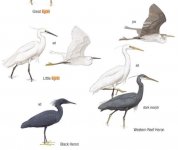I received my copy today, and I think if one already has Birds of the Middle East (2nd edition) by partly the same authors/illustrators, one can easily do without it. In many respects, this is simply a slimmed down version of the more comprehensive earlier FG. Though it is said to have been updated as well. At any rate, I think this is a very fine FG, and it will be a more compact book to take along for a visit to just Oman and nearby regions such as UAE. There is again a comparison plate for "Large White-headed Gulls", but it is covering three species only instead of the eight species covered in Birds of the Middle East. Nevertheless, it is in that context that the new book has some more detailed illustrations not found in the older book. Otherwise, I have so far only been able to find some slight modifications like on the belly of the Barn Owl (spots or no spots), and size differences as there are often less species per plate that can thus be shown a bit more enlarged.
As in the older volume, I am missing a Quick-find Index. In these times of constant sequence changes, such an index would seem mandatory for any new FG!! The Oman book retains the raptors as a unit, and thus falcons are not moved further back to the parrots. A most welcome decision. However, there are many other sequence shifts as a quick comparison of the contents pages up front shows. Examples are switches between Phasianidae and Anatidae, or between Caprimulgidae and Strigidae. There is a checklist at the end of the book that I feel is a bit problematical. For one, non-naturalized escapes are excluded. More importantly, however, the species sequence strictly follows the one adopted by the IOC, whereas the book does not. Thus some confusion will be inevitable. It might have helped to have the plate number given with the species names.
Finally, this book has the same good distribution maps as the earlier one, with just a reduced part of the range shown, of course. What is completely missing, however, is a map giving the names of the countries. Thus, one does not even see, which part of the map is actually Oman. Birds of the Middle East has at least such a map on the inside of the front cover. Fortunately, there is no shortage in the internet of suitable maps that one can copy and glue to an empty page such as the insides of the cover.
As a side remark, it is interesting to see that this book (the same Helm edition) is shown for a release date of 28 February 2018 on both the German and the US Amazon.
Edit: after some more in depth studying, I notice some more additional illustrations. Thus, there is now a depiction of the Eastern Cattle Egret in breeding plumage, and there is an additional illustration for the Kurdish (formerly Kurdistan) Wheatear, to just name two. But over all, there are very few such additions, I think.








